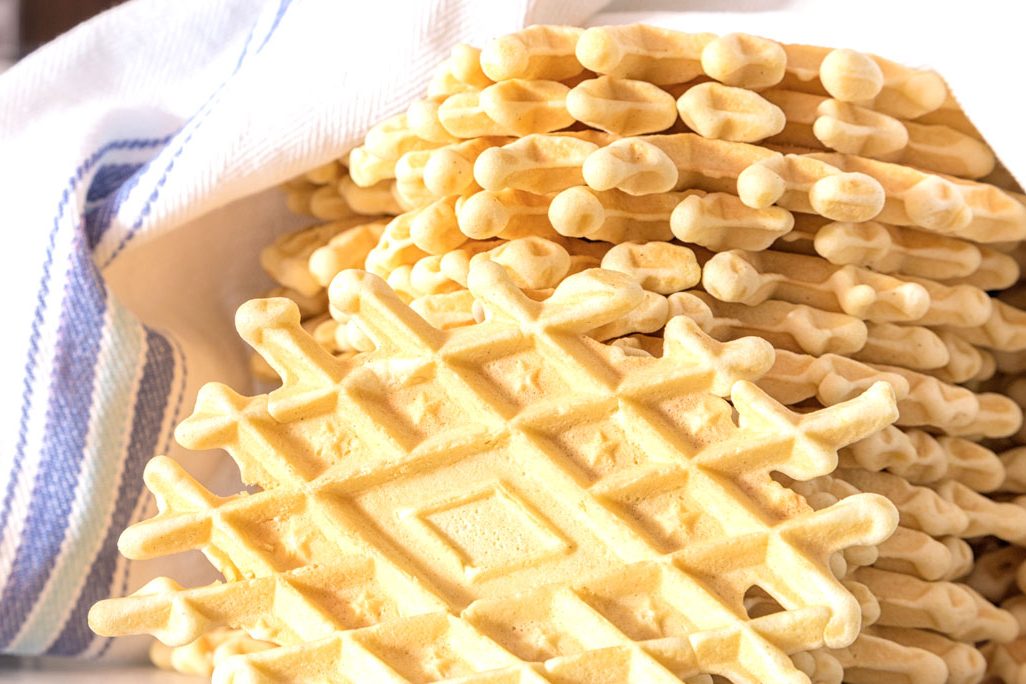Polenta, the gift from the new world to the old, and a gift from my grandmother to me. This was a favorite dish of my father, William Anthony Crocetti. It was a staple, one of those humble, family-style dishes that his mother, Angela, made for her husband, Gaetano, and her two sons – my dad William, and his younger brother, Dino. She cooked it up at her stove and served it family-style in a huge earthenware serving bowl.
It must have warmed both body and soul on those cold nights in their home above my grandfather’s barber shop in Steubenville, Ohio. Though not a dish native to my grandfather’s region of Abruzzo, “Pop”, as we called him, loved creamy golden hued polenta, thickened by a long cooking time, and brimming with the flavor of corn. My grandmother learned to make it from the Catholic nuns who raised her. I can only surmise that some of those nuns must have hailed from Piemonte, the birthplace of this sumptuous, yet simple dish.
My grandmother taught me to make polenta almost as soon as I could stand at the stove. I was not even tall enough to see over the edge of the stovetop before she pulled her kitchen stool over and told me to step up, quite literally. She poured the water into the pot, turned on the heat, and I filled my little hand with polenta. She watched as I slowly let the golden grains fall like rain through the tiny fingers of one hand and into the vortex of the boiling water that I stirred with the other. I held her long handled wooden spoon and stirred as if my life depended on it. My dinner certainly did. “Don’t stop stirring, piccina,” she said “or you’ll get lumps.”
The spoon’s long handle serves a real purpose in the preparation of polenta. As it simmers away, absorbing the water, the grains swell, and the mixture forms a thick mass that spits and sputters like lava. The long handle allows the cook to keep his or her hand far enough away from the bubbling mass to prevent splatters and burns. Polenta takes about 40 minutes to cook, a long cooking time that brings out the full depth of flavor.
I make polenta to this day, and I serve this very versatile food in many ways. Sometimes plain, cooked with water and seasoned with salt and pepper, a couple of bay leaves, and a splash of olive oil. Other times I layer it in a baking dish with a ragu, either sausage, meat or mushroom, for a delightful pasticciata. Cooked polenta, once chilled, can be cut into cubes and topped with grilled vegetables for a tasty antipasto. Or grill a slice or two for a delightful accompaniment to grilled meats. Let your imagination be your guide. Whether you choose a yellow or white polenta or coarse or medium grind, this is Italian comfort food at its very best.
Polenta Concia
Polenta with Cheeses and Sage
serves 6 to 8
·7 ½ cups cold water
·1 ⅔ cups (9 ¾ ounces) coarse yellow polenta
·¼ cup (¾ ounce) grated Parmigiano-Reggiano (OR Grana Padano), plus more for serving
·2 cups (6 ounces) grated Italian Fontina
·½ cup Mascarpone
Fine sea salt and black pepper
·4 tablespoons (2 ounces) unsalted butter
·About 12-14 sage leaves
Pour the cold water into a heavy bottom 4 to 6-quart saucepan or Dutch oven. Add 1 tablespoon of sea salt. Turn the flame to high. Slowly sprinkle the polenta into the water, being careful not to add the polenta all at once. To do so will risk forming lumps. Just pick up a handful of polenta, and let it fall slowly through your fingers, stirring all the while. Once all the polenta has been added, decrease heat to medium-low and cook, stirring the mixture constantly with a wooden spoon to prevent scorching. If any lumps do form, use the wooden spoon to mash them. Continue cooking until the mixture becomes quite thick and glossy and pulls away from the bottom and sides of the pan, about 40 minutes.
Meanwhile melt 3 tablespoons of unsalted butter in a small skillet. Mince some of the sage leaves, leaving enough whole ones to top each serving. Add the minced and whole leaves to the butter and fry until fragrant and slightly crispy. If desired, you can cook the butter until it has browned for an extra layer of flavor.
Once the polenta has thickened, remove it from the heat and add 1 tablespoon softened unsalted butter, grated Fontina, ¼ cup grated Parmigiano (or Grana Padano), and Mascarpone. Stir until all the butter and cheeses have completely melted and are well amalgamated. Add the cooked, minced sage leaves and most of the butter, reserving some butter and the whole leaves to top the polenta once it is served. Season to taste with salt and freshly ground black pepper, as needed.
Serve family style at the table or in separate serving bowls. Top with additional grated Parmigiano-Reggiano and butter with sage leaves. Serve immediately.
Questions? Email me at adri@AdriBarrCrocetti.com or visit AdriBarrCrocetti.com































